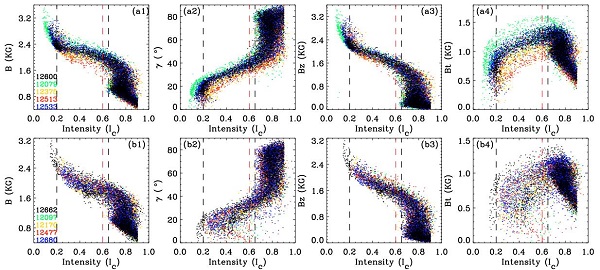Prof. YAN Xiaoli from Yunnan Observatories of the Chinese Academy of Sciences and Post-doctor LI Qiaoling from Department of Physics and Astronomy of Yunnan University, determined the bright-magnetic relationships for the decaying sunspots for the first time, and the results have been published recently in The Astrophysical Journal.
The brightness of sunspot is an important parameter in the study of the total irradiance of the Sun and a key index to verify the dynamics and magnetic properties of sunspots. The relationship between sunspot brightness and its magnetic field strength is known as the bright-magnetic relationship.
The bright-magnetic relationship of sunspots can be used to estimate the Wilson Depression and curvature forces inside sunspots. The study of the bright-magnetic relationship of sunspots is helpful to understand the brightness and atmospheric structure of sunspots, and provides constraints for the theoretical model of the energy transport mechanism of sunspots. Previous observational studies on the bright-magnetic relationship of sunspots have mostly focused on stable sunspots, but few has studied the bright-magnetic relationship of decaying sunspots.
Prof. YAN Xiaoli and their cooperators analyzed the difference of the bright-magnetic relationship between the stable and decaying sunspots by using the stray light calibration data from the Solar Dynamics Observatory Helioseismic and Magnetic Imaging (SDO/HMI). By comparison, it is found that the difference of the bright-magnetic relationship between stable and decaying sunspots is mainly manifested in the continuum intensity (brightness) range from 0.35 Iqs to 0.65 Iqs (Iqs is the average continuum intensity of the quiet Sun). In the decaying sunspot, the relationship between the continuum intensity and the transverse magnetic field strength shows a higher degree of dispersion (as shown in figure (a4) and (b4)).
In addition, the researchers found a bifurcation structure in the relationship between the continuum intensity and the transverse magnetic field strength during the formation of the light bridge. This bifurcation structure indicates that the two parts of the umbra separated by the light bridge have different thermodynamic properties.
It is also found that the continuum intensity of the sunspot umbra in decaying sunspots is brighter than that of a stable sunspot, and that the mean continuum intensity of the sunspot umbra gradually increases during the decay of sunspot. However, the mean continuum intensity of the penumbra does not change with the decay of the sunspot.
These results indicate that during the decay of sunspot, the temperature of the umbra increases gradually, but the temperature of the penumbra remains a constant. These results can provide a reliable observation basis for the theoretical study of sunspot decay.
This work is partially supported by the National Science Foundation of China (NSFC); Yunnan Key Laboratory of Solar Physics and Space Science.
Contact:
YAN Xiaoli
Yunnan Observatories, CAS
Email: yanxl@ynao.ac.cn

Figure 1. The relationship between the continuum intensity and the total magnetic field intensity, magnetic inclination, vertical magnetic field strength, and transverse magnetic field strength for the sunspot. The first row is for the stable spots, and the second row is for the decaying sunspot